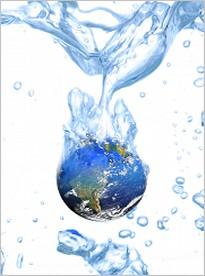Energy, the invisible water guzzler
Submitted by Trista Dorscher on | Updated Wed, 25/10/2017 - 16:29

World Water Day is a global event hosted by the UN in order to spread awareness on water related issues. This year, the theme of World Water Day is “Water and Jobs”. Half of the world’s population works in a water-related industry, and most jobs depend on the accessibility to clean, safe water. The main message this year revolves around protecting Earth’s water resources and, in turn, protecting our own livelihoods. In conjunction with World Water Day on March 22st, Canada Water Week runs from March 21st to 27th, raising awareness and inspiring Canadians to take action with events across the country. With climate change putting even greater pressure on our water resources, it’s time to talk water!
Only 2.5% of water on Earth is freshwater, and of that about 1% is useable. The remaining fresh water is contained in glaciers or in unreachable locations. Considering how much we depend on water for life, there’s no doubt this resource must be protected! But did you know that water conservation and reducing your carbon footprint actually go hand-in-hand?
When thinking about water conservation, our initial thought jumps to water in our own homes; cutting back on shower times, washing the dishes by hand, and not leaving the water running... all of which is awesome! These are really great ways to reduce your carbon footprint, but there is so much more to reducing water consumption than most people realize!
Water usage per capita for 16 countries. Source: http://www.conferenceboard.ca/hcp/details/environment/water-consumption....
Here in Canada, we are the second largest user of water globally, closely following our friends in the United States. In 2007 we yielded a water usage of 1,131 cubic meters per capita. That is 9 times larger than Denmark, one of the most water-friendly examples out there! What some people fail to realize is that these numbers are not reflective of residential water usage alone. In fact, energy production consumes more water than any other sector or activity. Furthermore, electric power generation accounts for nearly half of the water usage in the US! On average, 148 litres of water per person per day is used to produce power. This is partly because drilling and fracking practices require extremely large quantities of fresh water, so obtaining natural gas is a massive water-hogging activity. On top of this, natural gas is the main source used to heat water, and emits almost 1lb CO2 of per 1 Liter of water during heating!
So, how can we be more like our European pals and moderate our water usage? It all comes down to this fabulous two-for-one deal! By reducing the amount of energy you use around the home, in the office, and even through your mode of transport, you are also reducing your water footprint! Try these three simple tricks this Water Week, and who knows, maybe it will become a life-long water-saving habit!
Turn down the heat!
Approximately a quarter of the average household electricity bill is from heating water! Try reducing your shower time, even by just a minute or so! According to the Environmental Protection Agency (EPA), for an average 8-minute shower, approximately 70-liters of water are used. Depending on the source used to heat your shower, this can add up to an average of 1,368 lbs of carbon emitted each year per household. By reducing your 8-minute shower to 6 minutes instead, you can reduce these emissions by over 25%, and by an additional 50-60% if using a low-flow showerhead!
Other tricks to reducing the amount of water heating in your home could include washing the dishes by hand, and washing your clothes with cold water. 160lbs of carbon are emitted annually by your washing machine to heat the required amount of water. By switching the machine to a “cold” setting, you not only save a few liters of water per wash, but also reduce your carbon output by over 85%. Laundry detergent works the same whether it is a warm or cold wash, and it can even make your clothes last a little longer!
Additionally, on average, a 1000-watt electric heater will use over 150 litres of water in just one hour! With a natural gas heater, you can cut back over 300lbs of carbon emissions per year for every degree below 210C during the winter months, and 230lbs for an electric heater. Try setting that thermostat a little lower tonight, and maybe reach for a sweater or a blanket instead of flipping the switch.
Take a hike!
Depending on where your gasoline is coming from, up to 26 liters of water are required to produce just one liter of gasoline. So, a 40-litre tank of gas can equate to over one thousand liters of water! Ditch the car keys and invest in a bus pass, or walk whenever possible. Not only will this reduce your water consumption, but it is also a great way to emit less carbon and gain a little bit of exercise! In most cities across the US and Canada, you can reduce your emissions by over 800lbs of carbon per year by taking a bus for a daily commute, and save over 36,000 liters of water!
Drink responsibly!
Plastic water bottles use much more water during production than they’re worth. A single liters water bottle requires more than three liters of water during production! Where is the sense in that? Additionally, it was estimated that in 2006, bottling water produced more that 2.5 million tons of carbon dioxide! Reusable water bottles will therefore reduce your carbon and your water footprints!
These three tips seem overly simple at first, but that’s the beauty of them. Reducing your water and carbon footprints can be easier than you would think! Have fun trying them out, and have a happy Water Week!
Sources:
Canada Water Week (2016) Freshwater leadership http://canadawaterweek.com
Environment and Climate Change Canada (2010) Water Works! https://www.ec.gc.ca/eau-water/default.asp?lang=en&n=00EEE0E6-1
Forest reserves Champaign Country, Facts Chart http://ccfpd.org/NaturalResources/Facts_Chart.pdf
Grace Communications Foundation (2016) Water Saving Tips: Energy Use http://www.gracelinks.org/2970/water-saving-tips-energy-use
Pacific Institute (2007) Bottled Water and Energy Fact Sheet http://pacinst.org/publication/bottled-water-and-energy-a-fact-sheet/
Scientific American (2011) How Saving Energy Means Conserving Water in the U.S. http://www.scientificamerican.com/article/how-saving-energy-means-conserving-water/
UN World Water Day (2016) Water and Jobs http://www.unwater.org/worldwaterday/about/en/
Water Governance Canada, (2007) Program on Water Governance http://watergovernance.ca/wp-content/uploads/2010/04/FS_Water_Use.pdf
WaterSense, U.S. Environmental Protection Agency (2016) Make the Drops-to-Watts Connect http://www3.epa.gov/watersense/pubs/waterenergy.html
Wu, M. and Chiu, Y. Argonne National Laboratory (2011). Consumptive Water Use in the Production of Ethanol and Petroleum Gasoline – 2011 Update. Available at https://greet.es.anl.gov/publication-consumptive-water
You will save the Earth by sharing and/or tweeting (corny right?)





